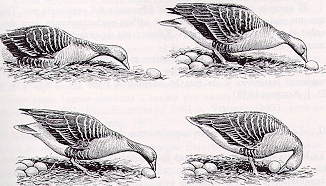

Short facts on brain and behavior
Instinctive
Behavior: Fixed Action Patterns
Silvia Helena Cardoso,
PhD


Instinctive
Behavior: Fixed Action Patterns
Silvia Helena Cardoso,
PhD
One of the most curious scenes I have ever
seen in animal behavior
is one of a bird (a cardinal) feeding
insects to "minnows" in a small pond (Fig 1).

Fig.1. In a small pond, a cardinal feeds minnows, which rose to the surface looking for food. During several weeks the bird fed them, probably because his nest had been destroyed. Taken from Animal Behavior, N. Tinbergen, Time Inc, 1966. |
Touching, if it were not for one reason: the bird did not "pity" nor showed "solidarity" with the hungry fish, sharing the food. What probably happened is that, having lost his nestlings, the bird inadequately responded to a dominant parental instinct, that is, the sight of stimuli similar to his nestling (small open mouths) elicited an inborn and stereotpypic behavior, known in ethology as FAP or instictive mechanical acts. FAP are stereotypic and inborn behavior. They are genetically determined and present a complex interaction with environmental stimuli. The Dutch ethologist Niko Tinbergen, Nobel Prize, was one of the first to study FAP in vertebrates, such as seagulls, ducks and so on.
A classical example of FAP studied by Tinbergen
is the goose behavior of picking eggs up. When the female notices an egg
outside the nest (key stimulus) , it begins a repeated movement to drag
the egg with its beak and neck. However if the egg slides off or if it
is removed by the researcher, the goose continues to repeat the stereotypic
movements even if the egg is absent, until it reaches the nest, when then
it does it all over again. Therefore, FAP seems to correspond to a fixed
neural circuitry elicited by the overall trigger stimuli.

Fig. 2. Female goose behavior of picking eggs up. When it sees an egg outside the nest (key stimulus), it begins a repeated movement of dragging the egg with its beak and neck. However, if the eggs slides off or if it is removed by the researcher, the goose continues to repeat the stereotypic movements even if the egg is absent, until it reaches the nest, when then it does it all over again. FAP seems to correspond to a fixed neural circuitry elicited by the overall trigger stimuli. Taken from Etologia - Introdución
Al Estudio Comparado del
|
Human beings also display various instictive
movements, which generally manifest themselves soon after birth. They are
called behavioral reflexes. One example is the characteristic prehensive
reflex of the hand of new-borns, who firmly hold any object.
Quantitative measures showed that infants
apply more strength if they touch hair. This FAP appeared by evolution
among primates, so that the infant can hold to the mother's hair and do
not fall off when she moves briskly. Given a rope, new-borns hold firmly
and remain suspended by themselves.

Fig. 3. Human beings also display several instinctive motor behaviors, which generally manifest themselves immediately after birth. They are called behavioral reflexes, such as when a new-born firmly holds a rope and he can be lifted. This behavior appeared in evolution among the primates, so that infants hold to the mothers' hair and do not fall off when she moves briskly. Taken from Etologia - Introducción Al Estudio Comparado del Comportamiento. I. Eibl-Eibesfeldt Ediciones Omega - Barcelona, 1974 |
Versão para o inglês: José Valter Arcanjo da Ponte, biólogo com DEA em fisiologia vegetal pela Universidade de Paris VII, França. Atualmente é Pesquisador Associado do Núcleo de Informática Biomédica.